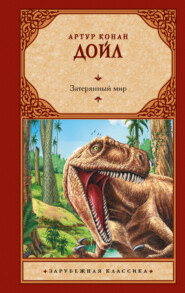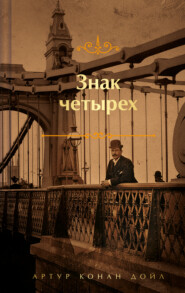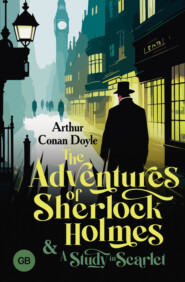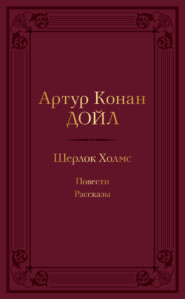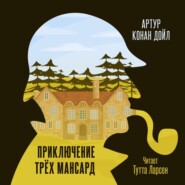По всем вопросам обращайтесь на: info@litportal.ru
(©) 2003-2024.
✖
Arthur Conan Doyle: A Life in Letters
Настройки чтения
Размер шрифта
Высота строк
Поля
Arthur Conan Doyle: A Life in Letters
Daniel Stashower
Jon L. Lellenberg
Charles Foley
Arthur Conan Doyle
A collection of letters between Arthur Conan Doyle (author and creator of Sherlock Holmes) and his mother, covering most of his life, written between 1867 and the year of her death in 1921.Doyle was raised almost solely by his mother in Dickensian circumstances, (his father latterly suffered from dipsomania and epilepsy and so spent much of his later life in asylums).Since Sherlock Holmes's inception in 1887, he has been one of the best-known and widely read literary characters, and the subject of more radio and television shows and motion pictures than any other fictional character in history. Although Doyle and his Holmes continue to be much written about, talked about and adapted, this is the first time that this material, along with other personal papers, has ever been made available.Conan Doyle although most famously remembered for Holmes, was also a physician, sportsman, public figure, war correspondent, pioneer of science fiction, psychic investigator, and prominent spiritual missionary.These letters reveal fascinating portraits of Doyle: his trip to the Arctic aged 21 where he served as a ship's surgeon on a whaling ship; his unprofitable stint as a Harley Street doctor and his decision to abandon this in favour of writing, more money and the opportunity to help his mother to look after his many younger brothers and sisters; his friendships with J.M.Barrie (among others); his attempts to write material other than Holmes; and his involvement in the spiritualist movement – something that his mother, a devout Roman Catholic, was completely against.‘Mam’ as he called her, was his most loyal confidant, and his letters functioned to a certain extent as confession and cleansing penance, until his mother’s death in 1921.The collection is annotated by Daniel Stashower, award-winning mystery novelist and author of the recent Conan Doyle biography "Teller of Tales", and Jon Lellenberg, the U.S agent for the Conan Doyle estate.
A Life in Letters
Edited by Jon Lellenberg Daniel Stashower & Charles Foley
Arthur Conan Doyle
To the memory ofDame Jean Conan Doyle,whose wish it was that herfather’s letters be published
Table of Contents
Cover Page (#ud30ff87a-5e92-5704-903d-fe43bd77185c)
Title Page (#u1034d0e9-3165-58d8-8259-ea6340cbdecd)
Dedication (#u803615fd-46b1-5bdd-845f-2a6b43b974ec)
Introduction (#u933460d9-4f03-5dec-bfc3-2e7a3716e382)
1 - The Schoolboy (1867-1876) (#u02aab781-a161-52d0-a9af-105a511aa590)
2 - The Medical Student (1876-1882) (#u9a317a4f-b5f2-560c-b35f-410755dbc6d8)
3 - The Struggling Doctor (1882-1884) (#udec07aa9-4497-5207-937a-7ebaf15eaea5)
4 - Cracking the Oyster (1884-1890) (#litres_trial_promo)
5 - ‘Author of Sherlock Holmes’ (1891-1893) (#litres_trial_promo)
6 - Putting Holmes Behind Him (1894-1896) (#litres_trial_promo)
7 - Country Life (1896-1898) (#litres_trial_promo)
8 - War in South Africa (1899-1900) (#litres_trial_promo)
9 - Politics and Honours (1900-1902) (#litres_trial_promo)
10 - The Final Hindhead Years (1903-1907) (#litres_trial_promo)
11 - Windlesham to the Outbreak of War (1907-1914) (#litres_trial_promo)
12 - The World War (1914-1918) (#litres_trial_promo)
13 - His Last Crusade (1918-1920) (#litres_trial_promo)
Epilogue (#litres_trial_promo)
Acknowledgments (#litres_trial_promo)
Index (#litres_trial_promo)
Copyright (#litres_trial_promo)
About the Publisher (#litres_trial_promo)
Introduction (#ulink_c9c52189-cc2a-5d2c-92e9-f37563ae2a7a)
‘Your ingenious habit of not dating yourletters will make your biographer curse.’
—CONAN DOYLE’S LIFELONG FRIEND JAMES RYAN
More than seventy-five years after his death Conan Doyle remains one of the most popular and best-loved authors of modern times, and his legendary creation, Sherlock Holmes, remains a towering phenomenon. For all his success, he aspired to be more than a mere writer, and his life was not spent simply cranking out book after book. He was also a physician, a sportsman, a crusader for criminal and social justice, a war correspondent, a military historian, and ultimately a spokesman and missionary for a new religion. Conan Doyle lived a life as gripping as any of his own adventure tales, and his activities frequently placed him on the leading edge of public controversies.
Each chapter of his life was rife with drama. As a schoolboy he confounded his masters’ low expectations of him and became a prize-winning student. As a medical student he faced a tortuous academic grind at Edinburgh University, and found some relief in spending six months as a ship’s surgeon on an Arctic sealing and whaling expedition, risking his life upon the ice floes. As a penniless young doctor he overcame the treachery of a duplicitous colleague to establish a practice of his own, under constant threat of financial ruin. Upon finding fame as the author of the Sherlock Holmes stories, he travelled to America and became an apostle of what came to be known as ‘the special relationship’ between the two great English-speaking powers. He forged friendships with other writers such as Rudyard Kipling and James Barrie, and crossed swords with the likes of George Bernard Shaw. He helped introduce skiing to the Alps at a time when the sport was unknown there, and played cricket as an amateur against some of the best professionals.
There was tragedy and controversy in his life as well. In the early days of his fame Conan Doyle learned that his wife had contracted tuberculosis, and he took her to the restorative climates of Switzerland and Egypt seeking a cure. His character and resolve were sorely tested when he met and fell in love with another woman during the years of his wife’s decline. A staunch patriot, he went off to war in South Africa at the age of forty-one, wrote a history of it, and then defended the British cause against slanderous attacks by its enemies. When his service to the Crown brought a knighthood, he initially intended to refuse it; he finally accepted only at his mother’s insistence. At home and abroad he campaigned tirelessly for the victims of injustice, and for military reform as well, as he watched war with Germany approach. Too old to serve in the army in World War I, his determination to contribute took him to both Downing Street and the front lines. The war took half a dozen of his family, including his only brother and his oldest son. And when he confronted anew the spiritual uncertainties of his youth, and found comfort in a new religious belief, he was ridiculed for it.
Conan Doyle came from a distinguished family of artists who were Irish in origin, but by his time had lived in England for generations. His grandfather, John Doyle, was a celebrated political cartoonist known as ‘H.B.’, whose originals were sought by the British Museum. His uncle Richard designed the famous cover of Punch magazine, his uncle James compiled The Official Baronage of England, and his uncle Henry founded the National Gallery of Ireland. Three generations of Doyles, including Arthur himself, earned places in the Dictionary of National Biography.
His own father, Charles Doyle, was an artist as well. As a young man he went to Edinburgh to take a position with the city’s Office of Works, and there he met and married Mary Foley, a young Irish girl of seventeen, and they began to build a large family. ‘My father was in truth a great unrecognized genius,’ Conan Doyle said; ‘any sense I have for dramatic effect corresponds to the artistic nature of my father.’ But Charles Doyle fell prey to alcohol in Edinburgh, and more and more the burden of supporting and raising the children came to rest upon their mother.
Mary Foley was remarkable in her own right. She was better educated than women usually were in Victorian Britain, spoke French and got much of her information about the world from the Revue des Deux Mondes, did heraldry for a hobby, and was greatly interested in genealogy and history—the origin of the historical fiction that her son loved to write more than anything else. ‘My real love for letters, my instinct for storytelling, springs from my mother,’ said Conan Doyle, ‘who is of Anglo-Celtic stock, with the glamour and romance of the Celt very strongly marked. In my early childhood, as far back as I can remember, the vivid stories she would tell me stand out so clearly that they obscure the real facts of my life. It is not only that she was a wonderful storyteller, but she had an art of sinking her voice to a horror-stricken whisper when she came to a crisis in the narrative, which makes me goose-fleshy now when I think of it. It was in attempting to emulate these stories of my childhood that I began weaving dreams myself.’ Though small in stature, she was a commanding personality who raised seven children largely on her own, and saw in Arthur the greatest hope of the family.
Born in Scotland, with parents of Irish descent, Conan Doyle nonetheless thought of himself as an Englishman, though the cultural strains of all three peoples would remain with him throughout his life. ‘I am half Irish, you know,’ he once told one of London’s press lords, after losing his temper over a newspaper story, ‘and my British half has the devil of a job to hold the hotheaded rascal in.’ He was always conscious of his diverse makeup, living his adult life in England among its literary and social circles but standing for Parliament twice in Scotland, and taking a lifelong interest in the Irish Home Rule questions. Not all his colleagues managed to balance these disparate traits so successfully; two of his Irish-born collaborators in social and military reform movements would later be convicted of treason, and executed.
CONAN DOYLE’S LETTERS
Conan Doyle was a tireless correspondent, and few writers have left as full or vivid a record of their life and literary work. While he wrote hundreds of letters to the press and professional associates, the many he wrote to his mother were far more personal and introspective in nature, revealing a side of the man not previously known.
Conan Doyle admired his mother greatly, and she was his principal confidant his entire life. He went away to boarding school at the age of eight in 1867 (a year earlier than previously believed), starting the flow of letters that lasted until her death at the end of 1920, fifty-four years later. Roughly a thousand have survived, touching on nearly everything going on in his life, and letting us into his mind. They were among papers of his that were locked away for over fifty years because of family disagreements. They finally came to his youngest child, Dame Jean Conan Doyle, not long before her death in 1997, and were bequeathed by her to the British Library. Complementing them here are other letters to his father, his brother and sisters, and other figures in his life, which we have arranged and annotated to provide his life in letters. The correspondence constitutes a far more candid autobiography than the one that Conan Doyle actually published in the 1920s—called Memories and Adventures—which was long on adventures but deliberately short on the memories.
Virtually no aspect of Conan Doyle’s life and work goes unmentioned in these letters, and they depict his personality and life far more completely and candidly than any previous treatment. They also contain many discoveries that greatly extend and often contradict the existing knowledge of his life. Other members of his family come into sharper focus as well, including his father. Charles Doyle has been accused on little if any evidence of being a volatile, even violent figure in the home, but there is no sign of that in the many references here, only regret over the infirmities that blighted his life and strained the family’s resources. Other discoveries have led to previously unknown Conan Doyle work—including the only known example of his advertising copywriting, in verse, and a talk before four hundred physicians and the Prince of Wales that he called the most successful he’d ever given.
Gracefully written and consistently revealing, Arthur Conan Doyle’s letters illuminate every phase of his life, tracing his development from a schoolboy through his years as a fledgling story writer, then to the years of his immense success as a writer, becoming one of the most popular and influential voices of his time. He was a man of his era, and occasionally prone to its prejudices, though perhaps less than one might expect in the private correspondence of a man born in 1859. And occasionally he had a temper as well. We have left intact examples of these, and of what some today would call his politically incorrect views on various subjects. When Sidney Paget, the artist who illustrated Sherlock Holmes for the Strand magazine, came to paint Conan Doyle’s portrait in 1899, the author insisted upon being depicted ‘warts and all’. This is likewise a warts and all portrait, as he would not have approved of being presented as other than he was.
MARY FOLEY DOYLE
His mother’s influence is evident in every aspect of her son’s character. ‘The Mam’, as he called her,* (#ulink_67a8be24-977b-5416-aa3d-a999ae05f715) raised seven children in Victorian Edinburgh (two more died in infancy or childhood) in what were certainly straitened if not absolutely Dickensian circumstances. In later years Conan Doyle said his childhood had been spent in ‘the hardy and bracing atmosphere of poverty’, but that was a rather sunny way of looking at it, even though it appears to have been a genteel sort of poverty, usually with at least one servant in the household.
But Charles Doyle’s alcoholism led to his being pensioned off when still in his forties, deepening the family’s plight; and when he entered the first of a long series of sanatoria and asylums, it was his wife, Mary, who struggled successfully to hold the large family together. Throughout his life Conan Doyle felt a powerful debt to her, and a keen awareness of the many sacrifices she made to secure his education and his start in life. In his 1895 autobiographical novel, entitled The Stark Munro Letters, Conan Doyle gave an admiring portrait of his mother:
Daniel Stashower
Jon L. Lellenberg
Charles Foley
Arthur Conan Doyle
A collection of letters between Arthur Conan Doyle (author and creator of Sherlock Holmes) and his mother, covering most of his life, written between 1867 and the year of her death in 1921.Doyle was raised almost solely by his mother in Dickensian circumstances, (his father latterly suffered from dipsomania and epilepsy and so spent much of his later life in asylums).Since Sherlock Holmes's inception in 1887, he has been one of the best-known and widely read literary characters, and the subject of more radio and television shows and motion pictures than any other fictional character in history. Although Doyle and his Holmes continue to be much written about, talked about and adapted, this is the first time that this material, along with other personal papers, has ever been made available.Conan Doyle although most famously remembered for Holmes, was also a physician, sportsman, public figure, war correspondent, pioneer of science fiction, psychic investigator, and prominent spiritual missionary.These letters reveal fascinating portraits of Doyle: his trip to the Arctic aged 21 where he served as a ship's surgeon on a whaling ship; his unprofitable stint as a Harley Street doctor and his decision to abandon this in favour of writing, more money and the opportunity to help his mother to look after his many younger brothers and sisters; his friendships with J.M.Barrie (among others); his attempts to write material other than Holmes; and his involvement in the spiritualist movement – something that his mother, a devout Roman Catholic, was completely against.‘Mam’ as he called her, was his most loyal confidant, and his letters functioned to a certain extent as confession and cleansing penance, until his mother’s death in 1921.The collection is annotated by Daniel Stashower, award-winning mystery novelist and author of the recent Conan Doyle biography "Teller of Tales", and Jon Lellenberg, the U.S agent for the Conan Doyle estate.
A Life in Letters
Edited by Jon Lellenberg Daniel Stashower & Charles Foley
Arthur Conan Doyle
To the memory ofDame Jean Conan Doyle,whose wish it was that herfather’s letters be published
Table of Contents
Cover Page (#ud30ff87a-5e92-5704-903d-fe43bd77185c)
Title Page (#u1034d0e9-3165-58d8-8259-ea6340cbdecd)
Dedication (#u803615fd-46b1-5bdd-845f-2a6b43b974ec)
Introduction (#u933460d9-4f03-5dec-bfc3-2e7a3716e382)
1 - The Schoolboy (1867-1876) (#u02aab781-a161-52d0-a9af-105a511aa590)
2 - The Medical Student (1876-1882) (#u9a317a4f-b5f2-560c-b35f-410755dbc6d8)
3 - The Struggling Doctor (1882-1884) (#udec07aa9-4497-5207-937a-7ebaf15eaea5)
4 - Cracking the Oyster (1884-1890) (#litres_trial_promo)
5 - ‘Author of Sherlock Holmes’ (1891-1893) (#litres_trial_promo)
6 - Putting Holmes Behind Him (1894-1896) (#litres_trial_promo)
7 - Country Life (1896-1898) (#litres_trial_promo)
8 - War in South Africa (1899-1900) (#litres_trial_promo)
9 - Politics and Honours (1900-1902) (#litres_trial_promo)
10 - The Final Hindhead Years (1903-1907) (#litres_trial_promo)
11 - Windlesham to the Outbreak of War (1907-1914) (#litres_trial_promo)
12 - The World War (1914-1918) (#litres_trial_promo)
13 - His Last Crusade (1918-1920) (#litres_trial_promo)
Epilogue (#litres_trial_promo)
Acknowledgments (#litres_trial_promo)
Index (#litres_trial_promo)
Copyright (#litres_trial_promo)
About the Publisher (#litres_trial_promo)
Introduction (#ulink_c9c52189-cc2a-5d2c-92e9-f37563ae2a7a)
‘Your ingenious habit of not dating yourletters will make your biographer curse.’
—CONAN DOYLE’S LIFELONG FRIEND JAMES RYAN
More than seventy-five years after his death Conan Doyle remains one of the most popular and best-loved authors of modern times, and his legendary creation, Sherlock Holmes, remains a towering phenomenon. For all his success, he aspired to be more than a mere writer, and his life was not spent simply cranking out book after book. He was also a physician, a sportsman, a crusader for criminal and social justice, a war correspondent, a military historian, and ultimately a spokesman and missionary for a new religion. Conan Doyle lived a life as gripping as any of his own adventure tales, and his activities frequently placed him on the leading edge of public controversies.
Each chapter of his life was rife with drama. As a schoolboy he confounded his masters’ low expectations of him and became a prize-winning student. As a medical student he faced a tortuous academic grind at Edinburgh University, and found some relief in spending six months as a ship’s surgeon on an Arctic sealing and whaling expedition, risking his life upon the ice floes. As a penniless young doctor he overcame the treachery of a duplicitous colleague to establish a practice of his own, under constant threat of financial ruin. Upon finding fame as the author of the Sherlock Holmes stories, he travelled to America and became an apostle of what came to be known as ‘the special relationship’ between the two great English-speaking powers. He forged friendships with other writers such as Rudyard Kipling and James Barrie, and crossed swords with the likes of George Bernard Shaw. He helped introduce skiing to the Alps at a time when the sport was unknown there, and played cricket as an amateur against some of the best professionals.
There was tragedy and controversy in his life as well. In the early days of his fame Conan Doyle learned that his wife had contracted tuberculosis, and he took her to the restorative climates of Switzerland and Egypt seeking a cure. His character and resolve were sorely tested when he met and fell in love with another woman during the years of his wife’s decline. A staunch patriot, he went off to war in South Africa at the age of forty-one, wrote a history of it, and then defended the British cause against slanderous attacks by its enemies. When his service to the Crown brought a knighthood, he initially intended to refuse it; he finally accepted only at his mother’s insistence. At home and abroad he campaigned tirelessly for the victims of injustice, and for military reform as well, as he watched war with Germany approach. Too old to serve in the army in World War I, his determination to contribute took him to both Downing Street and the front lines. The war took half a dozen of his family, including his only brother and his oldest son. And when he confronted anew the spiritual uncertainties of his youth, and found comfort in a new religious belief, he was ridiculed for it.
Conan Doyle came from a distinguished family of artists who were Irish in origin, but by his time had lived in England for generations. His grandfather, John Doyle, was a celebrated political cartoonist known as ‘H.B.’, whose originals were sought by the British Museum. His uncle Richard designed the famous cover of Punch magazine, his uncle James compiled The Official Baronage of England, and his uncle Henry founded the National Gallery of Ireland. Three generations of Doyles, including Arthur himself, earned places in the Dictionary of National Biography.
His own father, Charles Doyle, was an artist as well. As a young man he went to Edinburgh to take a position with the city’s Office of Works, and there he met and married Mary Foley, a young Irish girl of seventeen, and they began to build a large family. ‘My father was in truth a great unrecognized genius,’ Conan Doyle said; ‘any sense I have for dramatic effect corresponds to the artistic nature of my father.’ But Charles Doyle fell prey to alcohol in Edinburgh, and more and more the burden of supporting and raising the children came to rest upon their mother.
Mary Foley was remarkable in her own right. She was better educated than women usually were in Victorian Britain, spoke French and got much of her information about the world from the Revue des Deux Mondes, did heraldry for a hobby, and was greatly interested in genealogy and history—the origin of the historical fiction that her son loved to write more than anything else. ‘My real love for letters, my instinct for storytelling, springs from my mother,’ said Conan Doyle, ‘who is of Anglo-Celtic stock, with the glamour and romance of the Celt very strongly marked. In my early childhood, as far back as I can remember, the vivid stories she would tell me stand out so clearly that they obscure the real facts of my life. It is not only that she was a wonderful storyteller, but she had an art of sinking her voice to a horror-stricken whisper when she came to a crisis in the narrative, which makes me goose-fleshy now when I think of it. It was in attempting to emulate these stories of my childhood that I began weaving dreams myself.’ Though small in stature, she was a commanding personality who raised seven children largely on her own, and saw in Arthur the greatest hope of the family.
Born in Scotland, with parents of Irish descent, Conan Doyle nonetheless thought of himself as an Englishman, though the cultural strains of all three peoples would remain with him throughout his life. ‘I am half Irish, you know,’ he once told one of London’s press lords, after losing his temper over a newspaper story, ‘and my British half has the devil of a job to hold the hotheaded rascal in.’ He was always conscious of his diverse makeup, living his adult life in England among its literary and social circles but standing for Parliament twice in Scotland, and taking a lifelong interest in the Irish Home Rule questions. Not all his colleagues managed to balance these disparate traits so successfully; two of his Irish-born collaborators in social and military reform movements would later be convicted of treason, and executed.
CONAN DOYLE’S LETTERS
Conan Doyle was a tireless correspondent, and few writers have left as full or vivid a record of their life and literary work. While he wrote hundreds of letters to the press and professional associates, the many he wrote to his mother were far more personal and introspective in nature, revealing a side of the man not previously known.
Conan Doyle admired his mother greatly, and she was his principal confidant his entire life. He went away to boarding school at the age of eight in 1867 (a year earlier than previously believed), starting the flow of letters that lasted until her death at the end of 1920, fifty-four years later. Roughly a thousand have survived, touching on nearly everything going on in his life, and letting us into his mind. They were among papers of his that were locked away for over fifty years because of family disagreements. They finally came to his youngest child, Dame Jean Conan Doyle, not long before her death in 1997, and were bequeathed by her to the British Library. Complementing them here are other letters to his father, his brother and sisters, and other figures in his life, which we have arranged and annotated to provide his life in letters. The correspondence constitutes a far more candid autobiography than the one that Conan Doyle actually published in the 1920s—called Memories and Adventures—which was long on adventures but deliberately short on the memories.
Virtually no aspect of Conan Doyle’s life and work goes unmentioned in these letters, and they depict his personality and life far more completely and candidly than any previous treatment. They also contain many discoveries that greatly extend and often contradict the existing knowledge of his life. Other members of his family come into sharper focus as well, including his father. Charles Doyle has been accused on little if any evidence of being a volatile, even violent figure in the home, but there is no sign of that in the many references here, only regret over the infirmities that blighted his life and strained the family’s resources. Other discoveries have led to previously unknown Conan Doyle work—including the only known example of his advertising copywriting, in verse, and a talk before four hundred physicians and the Prince of Wales that he called the most successful he’d ever given.
Gracefully written and consistently revealing, Arthur Conan Doyle’s letters illuminate every phase of his life, tracing his development from a schoolboy through his years as a fledgling story writer, then to the years of his immense success as a writer, becoming one of the most popular and influential voices of his time. He was a man of his era, and occasionally prone to its prejudices, though perhaps less than one might expect in the private correspondence of a man born in 1859. And occasionally he had a temper as well. We have left intact examples of these, and of what some today would call his politically incorrect views on various subjects. When Sidney Paget, the artist who illustrated Sherlock Holmes for the Strand magazine, came to paint Conan Doyle’s portrait in 1899, the author insisted upon being depicted ‘warts and all’. This is likewise a warts and all portrait, as he would not have approved of being presented as other than he was.
MARY FOLEY DOYLE
His mother’s influence is evident in every aspect of her son’s character. ‘The Mam’, as he called her,* (#ulink_67a8be24-977b-5416-aa3d-a999ae05f715) raised seven children in Victorian Edinburgh (two more died in infancy or childhood) in what were certainly straitened if not absolutely Dickensian circumstances. In later years Conan Doyle said his childhood had been spent in ‘the hardy and bracing atmosphere of poverty’, but that was a rather sunny way of looking at it, even though it appears to have been a genteel sort of poverty, usually with at least one servant in the household.
But Charles Doyle’s alcoholism led to his being pensioned off when still in his forties, deepening the family’s plight; and when he entered the first of a long series of sanatoria and asylums, it was his wife, Mary, who struggled successfully to hold the large family together. Throughout his life Conan Doyle felt a powerful debt to her, and a keen awareness of the many sacrifices she made to secure his education and his start in life. In his 1895 autobiographical novel, entitled The Stark Munro Letters, Conan Doyle gave an admiring portrait of his mother:







